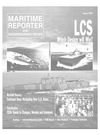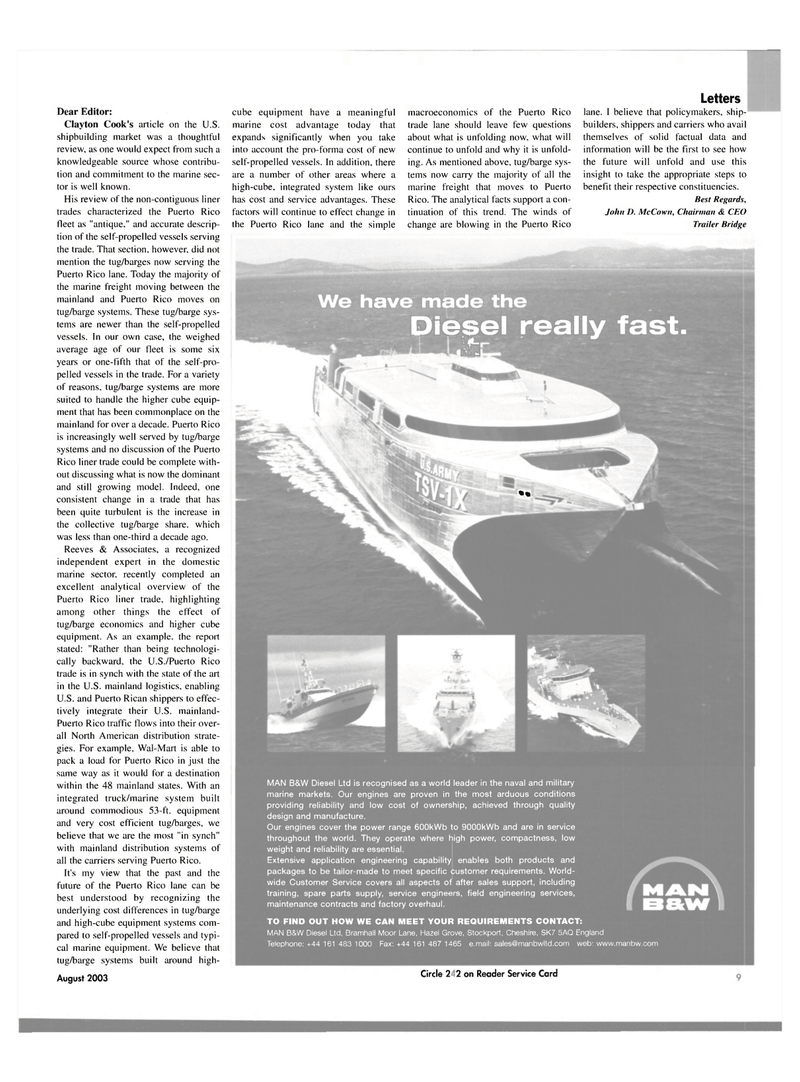
Page 9: of Maritime Reporter Magazine (August 2003)
Read this page in Pdf, Flash or Html5 edition of August 2003 Maritime Reporter Magazine
Dear Editor:
Clayton Cook's article on the U.S. shipbuilding market was a thoughtful review, as one would expect from such a knowledgeable source whose contribu- tion and commitment to the marine sec- tor is well known.
His review of the non-contiguous liner trades characterized the Puerto Rico fleet as "antique," and accurate descrip- tion of the self-propelled vessels serving the trade. That section, however, did not mention the tug/barges now serving the
Puerto Rico lane. Today the majority of the marine freight moving between the mainland and Puerto Rico moves on tug/barge systems. These tug/barge sys- tems are newer than the self-propelled vessels. In our own case, the weighed average age of our fleet is some six years or one-fifth that of the self-pro- pelled vessels in the trade. For a variety of reasons, tug/barge systems are more suited to handle the higher cube equip- ment that has been commonplace on the mainland for over a decade. Puerto Rico is increasingly well served by tug/barge systems and no discussion of the Puerto
Rico liner trade could be complete with- out discussing what is now the dominant and still growing model. Indeed, one consistent change in a trade that has been quite turbulent is the increase in the collective tug/barge share, which was less than one-third a decade ago.
Reeves & Associates, a recognized independent expert in the domestic marine sector, recently completed an excellent analytical overview of the
Puerto Rico liner trade, highlighting among other things the effect of tug/barge economics and higher cube equipment. As an example, the report stated: "Rather than being technologi- cally backward, the U.S./Puerto Rico trade is in synch with the state of the art in the U.S. mainland logistics, enabling
U.S. and Puerto Rican shippers to effec- tively integrate their U.S. mainland-
Puerto Rico traffic flows into their over- all North American distribution strate- gies. For example, Wal-Mart is able to pack a load for Puerto Rico in just the same way as it would for a destination within the 48 mainland states. With an integrated truck/marine system built around commodious 53-ft. equipment and very cost efficient tug/barges, we believe that we are the most "in synch" with mainland distribution systems of all the carriers serving Puerto Rico.
It's my view that the past and the future of the Puerto Rico lane can be best understood by recognizing the underlying cost differences in tug/barge and high-cube equipment systems com- pared to self-propelled vessels and typi- cal marine equipment. We believe that tug/barge systems built around high-
August 2003 11
TO FIND OUT HOW WE CAN MEET YOUR REQUIREMENTS CONTACT:
MAN B&W Diesel Ltd, Bramhall Moor Lane, Hazel Grove, Stockport, Cheshire, SK7 5AQ England
Telephone:+44 161 483 1000 Fax:+44 161 487 1465 e.mail: [email protected] web: www.manbw.com
Circle 228 on Reader Service Card
MAN B&W Diesel Ltd is recognised as a world leader in the naval and military marine markets. Our engines are proven in the most arduous conditions providing reliability and low cost of ownership, achieved through quality design and manufacture.
Our engines cover the power range 600kWb to 9000kWb and are in service throughout the world. They operate where high power, compactness, low weight and reliability are essential.
Extensive application engineering capability enables both products and packages to be tailor-made to meet specific customer requirements. World- wide Customer Service covers all aspects of' after sales support, including training, spare parts supply, service engineers, field engineering services, maintenance contracts and factory overhaul. cube equipment have a meaningful marine cost advantage today that expands significantly when you take into account the pro-forma cost of new self-propelled vessels. In addition, there are a number of other areas where a high-cube, integrated system like ours has cost and service advantages. These factors will continue to effect change in the Puerto Rico lane and the simple macroeconomics of the Puerto Rico trade lane should leave few questions about what is unfolding now. what will continue to unfold and why it is unfold- ing. As mentioned above, tug/barge sys- tems now carry the majority of all the marine freight that moves to Puerto
Rico. The analytical facts support a con- tinuation of this trend. The winds of change are blowing in the Puerto Rico
Letters lane. I believe that policymakers, ship- builders, shippers and carriers who avail themselves of solid factual data and information will be the first to see how the future will unfold and use this insight to take the appropriate steps to benefit their respective constituencies.
Best Regards,
John D. McCown, Chairman & CEO
Trailer Bridge
We have made the
Diesel really fast. »»

 8
8

 10
10
